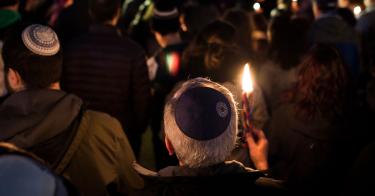On May 4, 1945, five days after Hitler’s death, African-American soldiers in the 761st Tank Battalion led the liberation of nearly 15,000 Jewish prisoners at the Gunskirchen concentration camp in Austria.
They had sacrificed mightily to get there, suffering heavy casualties during the Battle of the Bulge. Even before arriving in Europe, they had sacrificed, having battled for the right to join combat units reserved for white soldiers.
They were true heroes who, in the face of oppression at home, fought to defend oppressed Jews in a foreign land. When the soldiers of the 761st arrived back in America, they were greeted by segregation and Jim Crow. The benefits of the G.I. Bill, which expanded the economic horizons of so many white veterans by offering them housing and higher education, were largely not extended to African-Americans.
But unlike before the war, African-Americans were not alone. In the decade after the World War II ended, over 100,000 displaced Jews immigrated to the United States. Fresh in their memories were the faces of their liberators, white and black alike.
These survivors were stunned to find a whole race of people treated as second-class citizens in the United States, the country that had ensured the survival of the Jewish people.
So began what is now often referred to as the golden age of black-Jewish relations, during which time Jews and African-Americans fought side by side for civil rights. In the 1950s, the NAACP and Anti-Defamation League worked together to combat segregation. Jews notably made up almost half of those who led the 1964 Mississippi Freedom Summer, when hundreds of activists organized to register black voters, and three – two Jews and one African-American – were murdered by local police connected to the KKK.
In 1965, Rabbi Abraham Joshua Heschel, arguably the greatest Jewish theological leader of his era, marched across the Edmund Pettus Bridge with the Reverend Dr. Martin Luther King Jr., reflecting the powerful alliance that existed between the two peoples. “It would be impossible,” Dr. King once said, “to record the contribution that the Jewish people have made toward the Negro’s struggle for freedom – it has been so great.”
Though the bonds forged through mutual struggle and suffering were strong, the decades that followed the civil rights movement saw the relationship between Jews and African-Americans fray. Various policy disagreements led to political disconnects, and the resulting gap has left both our peoples vulnerable, as racism and antisemitism have risen around the world.
The data paint a grim picture. In 2018, the United States faced a 105% rise in antisemitic assaults, while the overall number of antisemitic incidents in the country remained near the all-time high set in 2017. Hate crimes, particularly those against African-Americans, rose in the United States for the fourth straight year. Indeed, blacks and Jews are targeted at similar rates; 23% of all hate crimes reported in major American cities were against blacks, while 19% were against Jews.
Today, cities like Poway, Pittsburgh and Charleston are connected by the shared experience of atrocity, often perpetuated by individuals who hate both Jews and African-Americans. Just this month, the FBI foiled an alleged white supremacist’s plot to bomb a synagogue in Colorado.
We are not idle in the face of these challenges. As current and former Trump administration officials, we spend our days working to advance American interests around the world. Ensuring equal opportunity, equal access, and the right to be who we are without fear of persecution are foremost among our priorities.
Nevertheless, there is much more Jews and African-Americans can do to stand together as a united front. Our two groups have a long history of supporting one another during the most trying times, and this moment in history demands a commensurate commitment. It demands a higher level of service from all of us in the name of rejecting hate and combating racial, ethnic and religious intolerance. It demands that those of us who have enjoyed the freedom to embrace our identities lift up those around America, and around the world, who have been less fortunate.
And it demands that we unite around our shared history as we work together to ensure that our heritage is preserved le’dor va’dor, from generation to generation.
It’s time for Jews and African-Americans to renew our proud tradition of mutual support that sustained our peoples through some of history’s greatest challenges. By joining forces, championing each other, and leveraging our combined power to speak and stand up for what’s right, we will ensure that future generations enjoy a world free of bigotry and persecution.
Paul Packer is the chairman of the United States Commission for the Preservation of America’s Heritage Abroad, a federal agency that protects and preserves historic sites of significance to American citizens. Dr. Kiron Skinner served as U.S. President Donald Trump’s former director of public planning at the State Department and is a Hoover Institution research fellow.
This piece originally appeared in The Jerusalem Post




